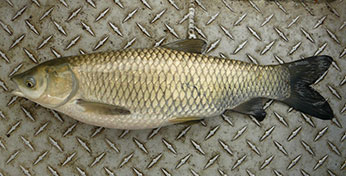(Ctenopharyngodon idella)
General Description
 Grass carp. Photo by Michigan Sea Grant.
Grass carp. Photo by Michigan Sea Grant.
Grass carp are large, freshwater fish belonging to the minnow family. They have an oblong body, round belly, and wide head. Adult grass carp are olive-brown on their backs and brassy or silvery on their sides, with white to yellow bellies. Grass carp have large, round scales that are outlined in black with a dark spot at the base. Grass carp have long, serrated, pharyngeal (throat) teeth that are used to chop and grind aquatic vegetation, which is their primary food source. Grass carp can grow to nearly 5 feet long and weigh up to 99 pounds. Grass carp closely resemble black carp, but can be distinguished by their lighter coloration and serrated, pharyngeal teeth.
Current Distribution
Through private stocking permits issued by the California Department of Fish and Wildlife (CDFW), triploid (sterile) grass carp are legally stocked in California in irrigation canals and golf course ponds for the purpose of aquatic vegetation control. Grass carp have been illegally introduced to California on numerous occasions over the years, with most attempts unsuccessful or resulting in eradication by CDFW. One wild, non-sterile population of grass carp is known to be present in a small, private pond in Siskiyou County. However, the pond does not provide suitable conditions for successful reproduction and CDFW is working with the landowner to ensure the population is contained. Grass carp were introduced to the United States in the 1960s, and have since been reported in 45 states, with reproducing populations present in the Mississippi River drainage and the Trinity River in Texas. Grass carp are native to large rivers of eastern Asia, from China and Russia to Thailand. They have been introduced all over the world, including Canada, Mexico, Central America, South America, Africa, Greater Antilles, the Pacific Islands, Europe, and throughout Asia outside of their natural range.
Habitat Preference
Grass Carp prefer shallow, abundantly vegetated waters of lakes, ponds, and backwaters of large rivers. They require riverine environments with long reaches, high water volume, turbulent flow, and warm water temperatures (66 to 84 °F) to successfully reproduce. Grass carp can tolerate a wide range of water temperatures (near freezing during the winter and near 100°F during the summer), low oxygen levels, and brackish water.
Pathways
In 1963, grass carp were introduced into the U.S. for aquaculture in Arkansas. They were later released into an Arkansas lake and the Arkansas River in the early 1970s and quickly spread to the Mississippi River drainage and established reproducing populations. In the U.S, they continue to be distributed via aquaculture operations, illegal and legal stocking for aquatic vegetation control and research, and escapement/release from isolated waterbodies to open waters. Grass carp are on California’s list of restricted animals and cannot be imported, transported, or possessed without a permit.
Impacts
Grass carp have a ravenous appetite for plants and can quickly reduce or eliminate large quantities of aquatic vegetation from waterbodies, which can lead to the alteration or loss of habitat for native species, reduction in food availability for waterfowl, and increased occurrences of algal blooms. While feeding, grass carp disturb sediment and muddy waters, which can impact spawning habitat for native fish. Grass carp carry diseases that are transmittable to other fish and are believed to be the main vector for Asian tapeworms.
Actions Taken if Found
Per California Code of Regulations (Title 14), any grass carp taken in Siskiyou and Shasta counties, within the Sacramento River drainage above and including Lake Shasta, shall be killed immediately by removing the head. CDFW shall be contacted as soon as possible and within 24 hours by calling (888) 334-2258. If found elsewhere, contact the CDFW Invasive Species Program at (866) 440-9530, or Invasives@wildlife.ca.gov to report your observation.